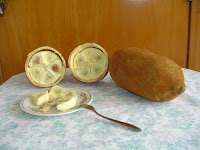Unusual Fruit -- NOT TO MISS CUISINE
Long before I met my husband, I spent 18 months living in Toronto, Canada. Most of the people I lived and worked with were from Latin America. I remember that one of the families I knew was from Colombia. On their wall was a large poster of the many different fruits of Colombia. Dozens of fruits that seemed completely unfamiliar. I remember thinking that it would be great to try all of them. And now, having tried many of them, I must recommend that you try some too. The fruits are definitely one of the NOT TO MISS CUISINE items of Colombia.
This week, with the focus on the Amazon regions of Colombia, I thought I would spotlight some of the amazing fruits of the region.

Seje -- found in the Amazon and Pacific Coast regions. This fruit is most similar to a date and is the size of a marble. It is cooked before serving. Unfortunately, I could not find a picture of this fruit.
Copoazu -- (Theobroma grandiflorum) -- This fruit is a relative of the cacao and its seeds can also produce chocolate. The plup is used to make marmalade.
An on -- (Annona squamosa) -- You eat the fleshy segments and spit out the hard seeds -- think watermelon. It is so delicious that it is well worth the trouble. It is never cooked.
on -- (Annona squamosa) -- You eat the fleshy segments and spit out the hard seeds -- think watermelon. It is so delicious that it is well worth the trouble. It is never cooked.
Why not give some of this fruit a try while in Colombia?
Photo:
http://commons.wikimedia.org/wiki/File:Cupua%C3%A7u.JPG
This week, with the focus on the Amazon regions of Colombia, I thought I would spotlight some of the amazing fruits of the region.

Seje -- found in the Amazon and Pacific Coast regions. This fruit is most similar to a date and is the size of a marble. It is cooked before serving. Unfortunately, I could not find a picture of this fruit.
Copoazu -- (Theobroma grandiflorum) -- This fruit is a relative of the cacao and its seeds can also produce chocolate. The plup is used to make marmalade.
An
 on -- (Annona squamosa) -- You eat the fleshy segments and spit out the hard seeds -- think watermelon. It is so delicious that it is well worth the trouble. It is never cooked.
on -- (Annona squamosa) -- You eat the fleshy segments and spit out the hard seeds -- think watermelon. It is so delicious that it is well worth the trouble. It is never cooked.Why not give some of this fruit a try while in Colombia?
Photo:
http://commons.wikimedia.org/wiki/File:Cupua%C3%A7u.JPG

Comments
1- Do not eat the skin of anything -- just eat the pulp.
2- Use the diluted bleach solution to rinse.
3- Don't buy pre-prepared drinks that are made with fruit and water unless you know the water is from a bottled source.
4- You will probably be staying somewhere where the cooks already use these techniques and you should be able to trust them. Most restaurants are okay. The real concern is stuff on the street.
In my own opinion:
I have eaten mango biche, pizza, empanadas, and all sorts of things off the street. I have gotten sick (though not that often -- once after eating raw sugar cane) and after one trip I did come home with giardia. I didn't mind the sugar cane experience, but giardia is horrible.